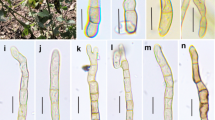Summary
Pseuderanthemum lilacinum Stapf is known from a single specimen collected in 1909 from Batu Caves, a karst limestone hill in Selangor, Peninsular Malaysia. Ridley had drawn attention to similarities between it and P. teijsmanni (C.B.Clarke) Stapf, which grows in lowland forest in Peninsular Malaysia. Examination of a range of specimens shows this conclusion to be correct and P. lilacinum becomes a synonym of P. teijsmannii. Confusion with the names Eranthemum teijsmanni T.Anderson, E. teijsmanni T.Anderson ex C.B.Clarke, Pseuderanthemum teysmanni Ridl., P. teijsmannii (C.B.Clarke) Stapf and Pseuderanthemum teysmannii (Miq.) Ridl. is resolved. Eranthemum teijsmanni T.Anderson is a nomen nudum without a type specimen. Eranthemum teijsmanni T.Anderson ex C.B.Clarke describes a Peninsular Malaysian taxon and is based on a detailed description and citation of specimens. In transferring Peninsular Eranthemum species to Pseuderanthemum, Ridley used the name P. teysmanni Ridl. for Clarke’s species. However, Stapf had already validated the combination in Pseuderanthemum and so this species should correctly be cited as P. teijsmannii (C.B.Clarke) Stapf. It is endemic in Peninsular Malaysia. P. teijsmannii (C.B.Clarke) Stapf and P. teysmannii (Miq.) Ridl. have both been misapplied to Chinese species, which are quite different from the Peninsular species.



Similar content being viewed by others
References
Anderson, T. (1868). List of Acanthaceae cultivated in the Royal Botanic Garden, Calcutta. J. Agric. Soc. India, n.s. I: 285 – 286.
Clarke, C. B. (1908). Eranthemum. J. Asiat. Soc. Bengal, Pt. 2, Nat. Hist. 74 (2): 674 – 680.
Choopan, T., Grote, P. J., Chayamarit, K. & Simpson, D. A. (2018). An annotated checklist of the genus Pseuderanthemum Radlk. (Acanthaceae) in Thailand. Thai Forest Bull., Bot. 46: 90 – 111.
Hu, J-Q., Deng, Y-F. & Daniel, T. F. (2011). Pseuderanthemum. In: P. H. Raven, Z-Y. Wu & D-Y. Hing, Flora of China 19: 439 – 440. Science Press, Beijing & Missouri Botanical Garden Press, St Louis.
Kiew, R. (2014). Checklist of vascular plants from Batu Caves, Selangor, Malaysia. Check List 10: 1420 – 1429.
____ & Rafidah, A. R. (2016). Rapid Biodiversity Assessment of Batu Caves, Mukim Selayang, Gombak District, Selangor, Peninsular Malaysia. Report for the Selangor State Government, Selangor. Forest Research Institute Malaysia (unpublished).
____, ____, Ong, P. T. & Ummul-Nazrah, A. R. (2017). Rare limestone plants in Peninsular Malaysia - what are they, where do they grow and how to conserve them. Malayan Naturalist 71: 33 – 41.
Ridley, H. N. (1923). Pseuderanthemum. In: H. N. Ridley, Flora of the Malay Peninsula 2: 588 – 592. L. Reeve & Co., London.
Stapf, O. (1912). Pseuderanthemum lilacinum. Curtis’s Bot. Mag. 138, t. 8446.
Tan, J. P. C. (2014). Paraboea species — saving near-extinct limestone flora. FRIM in Focus March: 4 – 5.
Van Steenis-Kruseman, M. J. (1950). Cyclopaedia of Collectors. Flora Malesiana Ser. I, 1: 3 – 639.
Acknowledgements
Grateful thanks to N. Mohamad Aidil, Imin Kamin, Mohd Hairul Mohd Amin, Wan Mohd Syafiq Wan Putra and Fakrullah Haziq Hashim of the KEP Herbarium, Forest Research Institute Malaysia, for providing crucial field support, team members of the Rapid Biodiversity Assessment of Batu Caves in 2016, and to the Selangor State Government for funding; to Malaysian Caves & Karst Conservancy that facilitated our survey in 2018 – 2019 as part of the Batu Caves Scientific Expedition, to the Majlis Perbandaran Selayang for granting permission to access the hill; and to the Curator at K for permission to examine herbarium specimens. This research was carried out under Project "Dokumentasi dan Konservasi Biodiversiti Demi Kesejahteraan Hutan dan Kemampanan Sumber Semulajadi (Fasa 1): Subproject 1 - Diversiti, Dokumentasi dan Status Konservasi Tumbuhan bagi Pengurusan Sumber Hutan Secara Mampan di Malaysia".
Author information
Authors and Affiliations
Corresponding author
Additional information
Publisher’s Note
Springer Nature remains neutral with regard to jurisdictional claims in published maps and institutional affiliations.
Rights and permissions
About this article
Cite this article
Kiew, R., Rafidah, A.R. The correct name for Pseuderanthemum lilacinum, P. teijsmannii and P. teysmannii (Acanthaceae) in Peninsular Malaysia. Kew Bull 77, 781–786 (2022). https://doi.org/10.1007/s12225-022-10036-1
Accepted:
Published:
Issue Date:
DOI: https://doi.org/10.1007/s12225-022-10036-1




